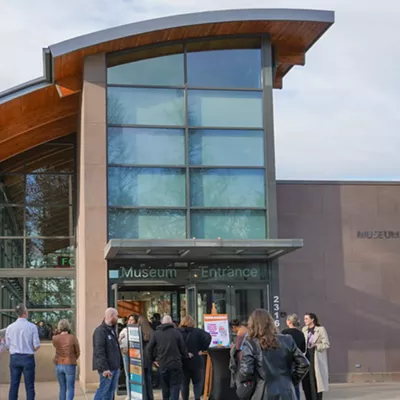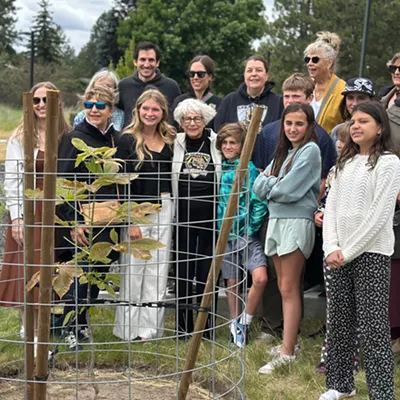One hundred years ago this spring, Spokane entrepreneur Jay P. Graves led a group of landowners who gave the city nearly 95 acres for a grand park. He was encouraged by his business associate, Aubrey L. White, who also served as president of the Park Board and director of the Chamber of Commerce.
But the history of Manito, like most histories, is more than a parade of prominent names. Two other gentlemen -- Francis H. Cook, a printer and entrepreneur who left his native Ohio at 19, and E. Charles Balzer, a German-born immigrant who became Spokane's first park superintendent -- deserve far more mention than they've received in the annals of Spokane's movers and shakers. No one knows if the two ever met, but their dreams came together on a rocky, pine-covered ledge a mile south of downtown Spokane, and their legacy remains with us today.
In 1884, Francis Cook purchased 40 acres on the Manito plateau, a tract that included the current site of the Cathedral of St. John the Evangelist. Cook, who founded Spokane's first newspaper in 1879, acquired an additional 160 acres -- including present-day Manito Park -- from the Northern Pacific Railroad two years later. Soon, his holdings on the South Hill would grow to more than 600 acres.
Cook farmed part of his land and hoped to develop new residential neighborhoods on much of the rest. In the center of his property lay a spring-fed body of water he dubbed Mirror Lake; basalt outcroppings towered around it and a grove of trees hugged the shore. Believing the area to be unsuitable for residential development, he named it Montrose Park -- a tribute to the wild roses growing there -- and hosted Spokane's first county fair on the site.
"The name Francis Cook kept popping up as we dug through the archives, and he doesn't get the credit we think he's due for the development of Manito Park," says Suzanne Schaeffer Bamonte, who has just completed a centennial edition of Manito Park: A Reflection of Spokane's Past with her husband, Tony Bamonte. "At that time, that area was still very much out in the country. People would hike up here, or come up on horseback."
Working with a partner, Cook launched the city's first motorized trolley service, the Spokane & amp; Montrose Motor Railroad, in 1888. The streetcars traveled up the newly developed Grand Boulevard to about 19th Avenue, depositing passengers at the entrance to the park. Despite the easy access of the streetcar line, Cook didn't sell many of his building sites, and the park and surrounding neighborhood remained largely undeveloped.
When the panic of 1893 hit, Cook found himself heavily mortgaged and eventually lost his company, his land and even his home. When property values crashed, those with available cash found some remarkable bargains. Graves bought Cook's streetcar line, reforming it as the Spokane Traction Company, and acquired much of Cook's former land as well. With the improving economy after the turn of the century, Graves sought to develop the land much as Cook had planned. He organized adjacent landowners and deeded the land to the city, a move Bamonte sees as a shrewd business deal.
"[Graves and the other landowners] were savvy real estate developers," she says. "They realized that the park would increase the value of their [residential] property and make it that much more enticing."
The gift didn't come without conditions, however. The city agreed to build roads through and around the park and to provide city water to the park and the surrounding residential lots. The improvements had to be maintained by the city and the property "used forever for the sole purpose of a public park."
"The agreement committed the city to a financial responsibility that I don't think the city realized at the time," says Bamonte. "I don't know that something like that would fly today. The city came close to losing that property because it was having a hard time with the financial obligations."
Graves and city leaders renamed the area Manito Park, thinking the Indian word "manito" referred to a place of high elevation. Meanwhile, Charles Balzer labored quietly in the background as the first park superintendent, moving the city's greenhouses to Manito and designing a grand floral arch for the park's main entrance. He created lush flower gardens and topiary displays and added a children's playground and a zoo complete with polar bears, bobcats, monkeys and birds. Visitors of an athletic bent could play softball or tennis or try the genteel sport of lawn bowling. The lake allowed for swimming in the summer and skating in the winter; movies, concerts and dancing attracted even more people.
During Balzer's tenure, Manito became a popular destination for family outings, especially on summer weekends. John Duncan, the next superintendent, added the formal garden that now bears his name and expanded the rose garden. He also began the changes to the lake and adjacent canal that would eventually reduce its size to the current configuration of the Duck Pond.
One persistent piece of misinformation about Manito regards the role of the famous Olmsted Brothers landscape architects, says Bamonte. The Olmsted firm included Manito Park in its review of Spokane's park system but did not design the park. By the time they arrived in 1907, Balzer's design was well established.
"They made a page or two of recommendations about Manito in their report," she says. "They said to do away with zoo, widen the road through the park, and add more grassy areas. Eventually the Park Board took their advice, but it took many years."
Manito Park continues to attract visitors -- about 200,000 annually, according to the Parks Department. But the park is not simply a remnant of a genteel past; it continues to evolve to meet the needs of Spokane residents. Spokane has grown up around the park, leaving Manito Park and the nearby boulevard as rare open green spaces amid the development of the city. Bamonte looks at the park today and recognizes the legacy of Cook and Balzer and others like them who envisioned a time when open space would be rare in the city.
"I think it was quite remarkable that they had the foresight to create the park," she says. "Some people realized that the city would be a booming metropolis, but at that time there was a lot of open space. But thank goodness it worked, because it's a wonderful piece of property for the city."
Publication date: 5/13/04















